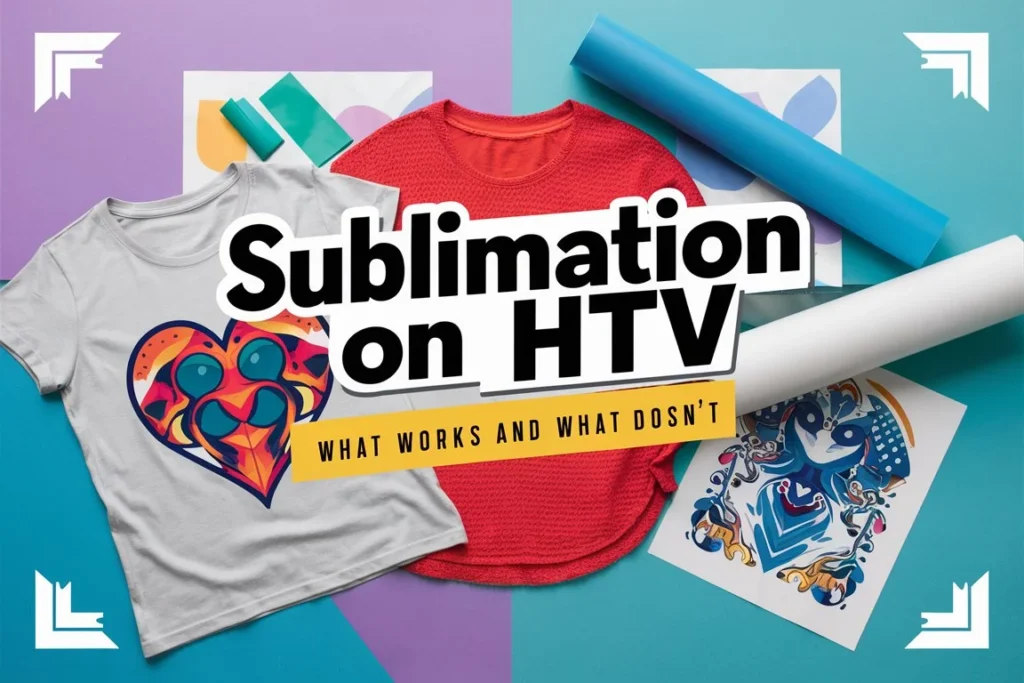Sublimation on HTV, Curious about sublimating on HTV (Heat Transfer Vinyl)? You’re in the right place! Today, we’ll cover everything you need to know about how to do it and what materials you’ll need. Let’s get started!
Table of Contents
Sublimation on HTV
What are we going to try? The two things that I’ve been getting the most requests to try are Siser EasyWeed HTV and regular Cricut Everyday Iron-On. Will these two work? We’re going to find out.
Let’s first understand about the supplies we are going to need of:
Supplies Needed:
- Clear Dye Sub HTV
- Siser Mystic White
- Cricut Everyday Iron-on
- Siser Easyweed
- Sublimation Ink
- Sublimation Paper
- Epson EcoTank Printer (I have the ET-4700 and here it is on Amazon and from Target – NOTE: Any EcoTank Printer should work for conversion.)
- Heat resistant tape Use code CCC10 for 10% off
- Cotton shirts (one black and one white)
Printing, Cutting, and Weeding the HTV
I used a Cricut machine to cut each HTV product and print my sublimation designs, ensuring they were the same size. All designs were printed on a sublimation printer with sublimation ink on best sublimation paper. For cutting, I used the iron-on setting for all HTV products, but the Siser Mystic White might have benefited from the holographic iron-on
setting. Remember to mirror your image when cutting these materials.
Note: For the Clear Dye Sub HTV, both sides are shiny. The rough side should go against the mat, and you should cut it on the iron-on setting. To determine the correct side, peel back a corner to identify the liner side.
I cut and weeded two of each heart to test them on both black and white shirts. You can cut the sublimation hearts with scissors—leaving a white edge around the design won’t affect the results.
Pressing HTV on Shirts
Before applying the vinyl and sublimation designs on the shirts, I’ll lint roll and pre-press each shirt to ensure they’re clean and dry. Here’s the plan: first, I’ll press the vinyl
pieces, then I’ll move on to sublimating them. Here are the temperatures and times I’ll use for each product:
- Dye sub clear 320 degrees Fahrenheit for five seconds, peel cold.
- Mystic white is 320 degrees Fahrenheit for 10 seconds, peel cold.
- Siser HTV is 305 degrees Fahrenheit for 10 seconds, peel hot.
- Cricut Everyday Iron-on is 315 degrees Fahrenheit for 15 seconds, peel cold.
This step is just for pressing the HTV on. Later, we’ll use different times and temperatures for the sublimation process on top.
HTV Before Sublimation
Let’s check these out before we move on to sublimation. The Clear Dye Sub was particularly challenging to get to stick to the shirt. The directions said 320 degrees for five seconds, but I ended up going with 320 degrees for 15 seconds—I just couldn’t get it to stick otherwise.
Note: Make sure to lint roll this one thoroughly before pressing, as lint was visible through mine after pressing.
In the image, the upper left shows the Clear Dye Sub, the upper right is the Mystic White, the bottom left is the Siser, and the bottom right is the Cricut.
NOTE: You can see that you can barely see the clear on the white, but the clear on the black looks off-white.
Sublimation on HTV
I’ll be sublimating my hearts on top of each HTV heart. Here’s my process: after lint rolling the heart, I’ll position the sublimation print as accurately as possible, tape it down, and then press it. Here are the times and temperatures I’ll be testing:
- Dye sub clear 380 for 30 seconds.
- The mystic white, Siser, and Cricut is 356 for 25 seconds. I’m kind of experimenting on these three, so I’m not sure.
Let’s examine each of these in detail before I put them in the laundry.
Note: I’ll wait 24 hours before washing any of the shirts. Also, I’m putting a sublimation heart on a polyester shirt that I won’t wash at all, so I’ll have something to compare to later.
Clear Dye Sub HTV
Here’s the sublimation on the Clear Dye Sub HTV. You can see it on black, white, and the shirt on the right is 100% polyester for comparison. This product isn’t suitable for colored shirts, but sublimation on the Clear Dye Sub HTV on white looks fantastic! I’m curious to see how it holds up after a few washes. As mentioned earlier, lint under the clear is still visible even after sublimation. I recommend thorough lint rolling before pressing the HTV.
Siser Mystic White
Below is a comparison between the black, white, and the 100% polyester shirt. The results look promising now. After washing, we’ll see how it holds up. The metallic color from the HTV does influence the sublimation print slightly, which can create a unique effect. You might actually find this look appealing.
Siser HTV
The print was very faint initially, so I adjusted by pressing at 380 degrees for about 20 seconds on both of these. This made the paper stick better. Currently, they appear to have a thin layer of paper on top. I’ll evaluate them after the first wash to see if this layer comes off and reveals brighter colors. However, as you can see, the colors are much lighter compared to the polyester sublimation shirt on the right.
Cricut Everyday Iron-On
The Cricut Everyday Iron-On turned out similar to the Siser above—quite light initially, so I pressed it again. There might still be some paper residue on it. The colors are still lighter compared to the polyester sublimation shirt. Stay tuned to see how they fare after washing.
Results After One Wash
Let’s examine the results after just one laundry cycle. There’s no more paper residue on both the Siser and the Cricut products, but unfortunately, there’s very little ink left as well. Most of the ink washed out in the first cycle. The top shirt is the 100% polyester one for comparison, showing how much fading occurred. I believe the regular white HTV from Siser and Cricut is not suitable. However, the Clear and Mystic White still look promising, so I’ll continue washing these shirts a few more times to see how they hold up
Results After Several Washes
Let’s check out the results after four laundry cycles. Its still incredibly vibrant. I’m really impressed with this product—it feels great on the shirt and has hardly faded at all. It’s definitely a winner in my book. However, it doesn’t look great on dark shirts; the dark colors show through. Stick with white or light-colored shirts when using this product.
Next up is the Siser Mystic White, which still looks great after four laundry cycles. Like with any holographic HTV, I’ve noticed it tends to crack or look wrinkled slightly. This is common with holographic materials. I washed all the cycles in cold water and hung them to dry. The polyester shirt is in the center for comparison, showing how well it retains its vibrancy. It also looks fantastic on dark shirts. If you’re a fan of the holographic look, I recommend trying out the Mystic White for sublimation on HTV—it’s definitely worth it!
Which Do I Recommend?
The clear winners for me were definitely the Clear Dye Sub and the Mystic White. Personally, I’m not a huge fan of holographic HTV, so the Mystic White isn’t my first choice, but you might enjoy its feel and appearance.
As for the Clear Dye Sub, its drawback is that it’s clear and can only be used on light-colored fabrics. However, the feel is incredible—it’s barely noticeable on the shirt. I would say it’s comparable to, or maybe even better than, EasySubli in terms of feel and quality.
If I were using a white cotton shirt, I would likely choose the Clear Dye Sub, but I’d ensure the shirt is completely free of lint before pressing.
As for sublimating on any HTV, the answer is no. It still needs to have some polyester content, which not all HTV products offer.
You can certainly experiment with different HTVs like I did here. If you’re curious about a specific HTV product, run some tests to see if it will work for sublimation. Testing is key to finding what works best heat transfer vinyl for your projects.
Try sublimation Heat Transfer Vinyl for your next project. You may love the look! If you are looking to do a cotton shirt, you might just find that sublimation on HTV is the clear winner for your project.


